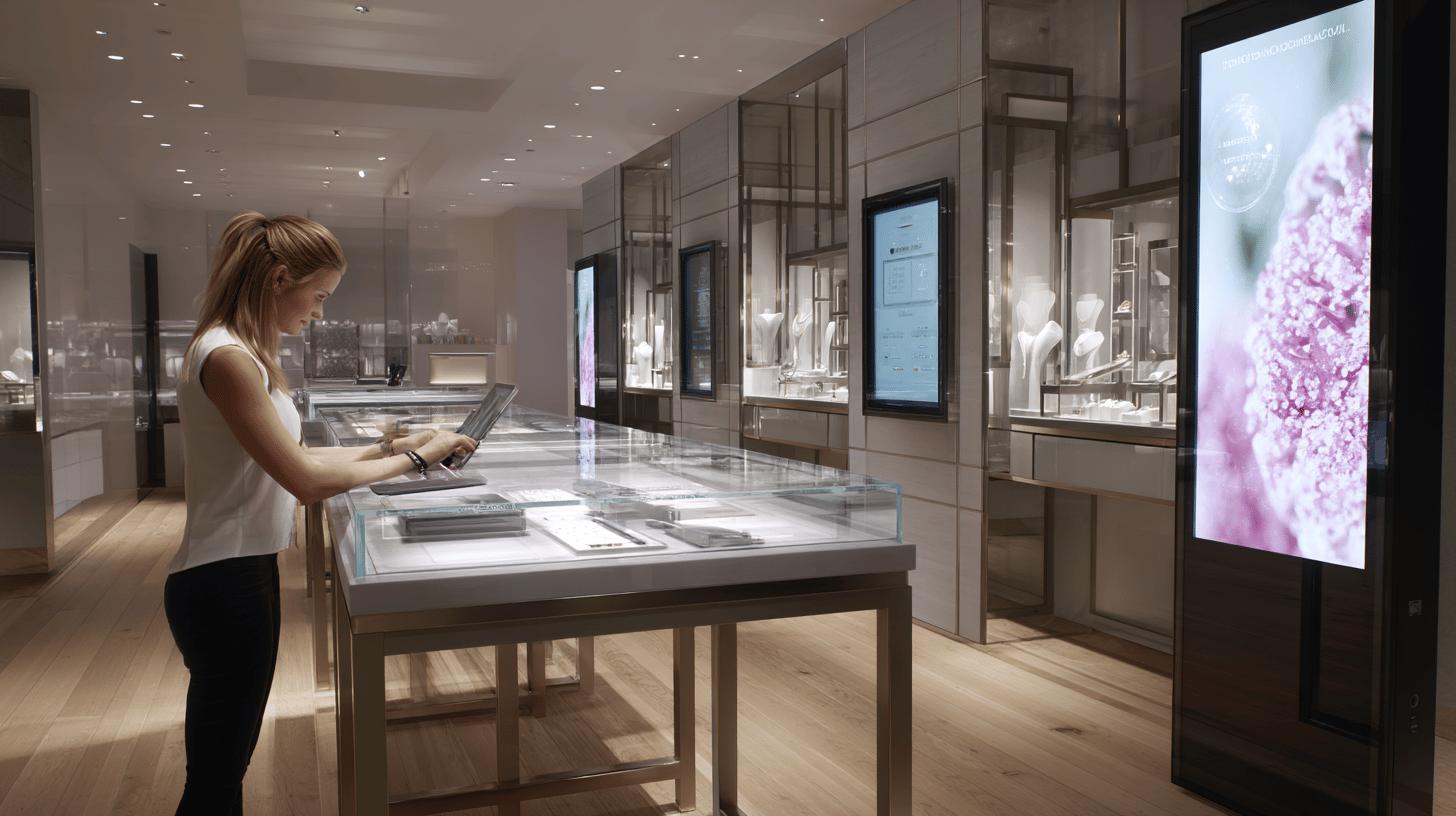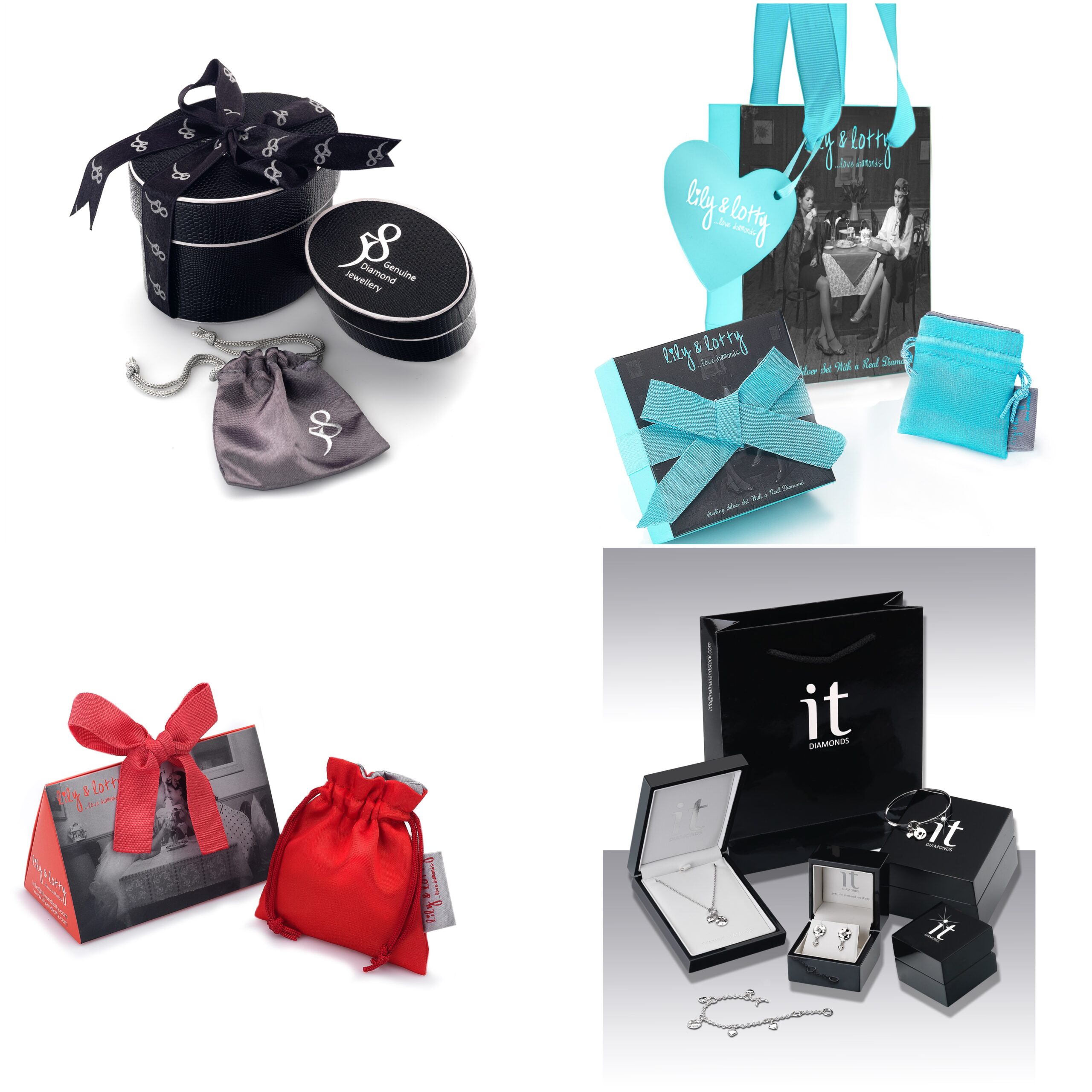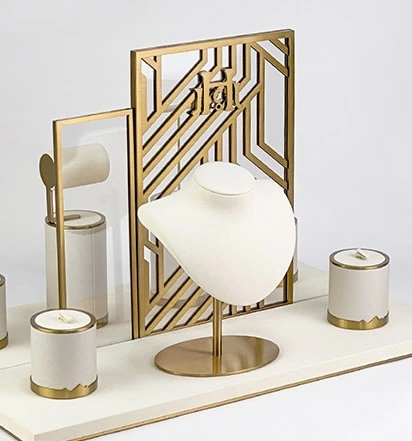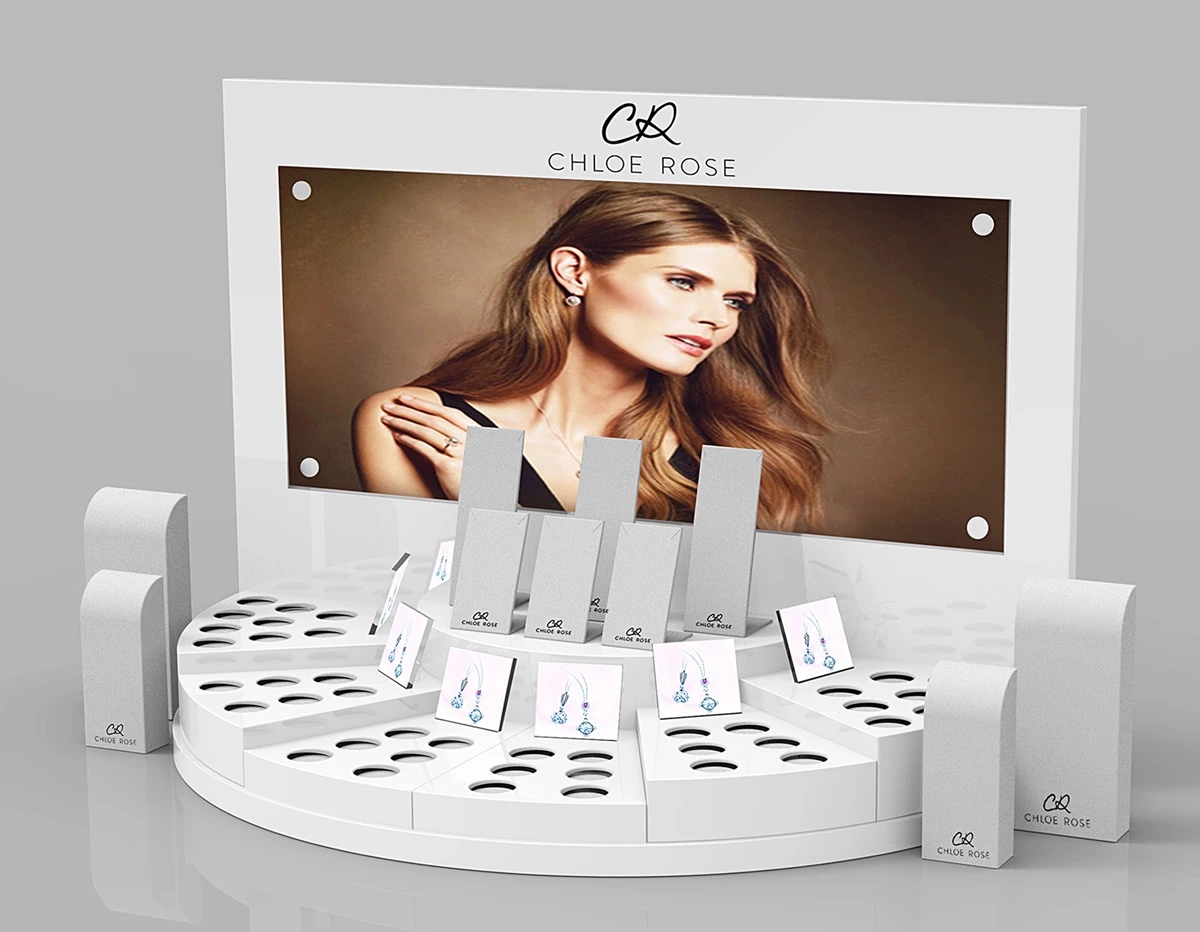In the ever-evolving landscape of jewellery retail, how can a store not only survive but thrive in 2025? By staying ahead with the latest jewellery display and shopfitting trends, retailers can create captivating shopping environments that draw in customers and elevate their brand presence. These trends combine the warmth of earthy tones with innovative materials like travertine and walnut wood, crafting inviting displays that captivate the modern clientele. As the industry pivots towards sustainability and advanced technology, understanding and adapting to these shifts will be crucial for any retailer aiming to maintain a competitive edge.
Embracing Jewellery Display Trends in 2025
Jewellery display trends in 2025 are shifting towards warm, earthy tones, creating a comfortable and inviting atmosphere that aligns with contemporary interior design. Fashion boutiques and jewellery brands are adopting tones such as taupe, brown, and beige, often complemented with brushed gold branding plaques, to establish a sophisticated and cohesive look. The emphasis is on cutting-edge materials that add texture and richness. Travertine and walnut wood are popular choices, providing a natural and luxurious feel. These materials not only enhance the aesthetic appeal but also offer durability and a sense of authenticity. The integration of layered textures further contributes to the depth and visual interest of displays, making them more engaging for consumers.
- Travertine
- Walnut wood
- Brushed gold accents
- Gold metallic elements
- Layered textures
.
Display lighting plays a crucial role in creating the perfect ambience for showcasing jewellery. It involves strategic use of light to highlight the brilliance and intricate details of pieces. Effective lighting can enhance the appearance of gemstones, drawing attention to their unique qualities and craftsmanship. By incorporating adjustable and energy-efficient lighting solutions, retailers can ensure that their displays remain dynamic and adaptable to different settings, ultimately providing a captivating shopping experience.
Innovations in Jewellery Shop Fitting for 2025
Sustainability is at the forefront of jewellery shop fitting innovations in 2025, reflecting the growing demand for eco-friendly practices. Retailers are increasingly turning to sustainable materials for displays, such as recycled metals and bio-based plastics, to reduce their environmental impact. This shift not only aligns with consumer values but also enhances brand reputation by demonstrating a commitment to environmental responsibility.
Modular shop fitting systems are gaining popularity due to their versatility and efficiency. These systems allow for easy reconfiguration of retail spaces, enabling retailers to adapt quickly to changing trends and customer needs without extensive renovations. The benefits include cost savings, as modular components can be reused and reassembled in various configurations. Additionally, modular systems support creative retail environments, allowing for unique and engaging layouts that enhance the shopping experience. By incorporating sustainable materials into these systems, retailers further contribute to eco-friendly practices while maintaining aesthetic appeal and functionality.
Luxury retailers are embracing these innovative shop fitting trends, recognising their potential to elevate customer experiences. By adopting modular and sustainable solutions, they create visually appealing spaces that resonate with environmentally conscious consumers. This approach not only improves the shopping atmosphere but also fosters a positive brand image. As a result, luxury retailers can differentiate themselves in a competitive market, attracting customers who prioritise sustainability and innovation in their purchasing decisions.
Leveraging Technology for Jewellery Retailers

Digital display technology is revolutionising the jewellery retail sector by enhancing customer engagement through immersive and interactive experiences. Retailers are increasingly adopting high-definition screens to showcase intricate jewellery details, enabling customers to view pieces up close without handling them. This technology not only highlights the craftsmanship and beauty of each item but also allows for dynamic content such as promotional videos and virtual catalogues. Interactive displays, featuring touch screens and augmented reality (AR) elements, offer customers the ability to explore product ranges and customise their selections in-store. This integration of digital technology aligns with contemporary consumer expectations for an engaging and personalised shopping journey.
Virtual fitting rooms are emerging as a vital tool in jewellery retail, offering customers the ability to try on pieces virtually without physical contact. These systems use AR to overlay jewellery items on a customer’s image in real time, allowing them to visualise how different pieces will look when worn. This innovation addresses hygiene concerns while also providing a convenient and novel shopping experience. It empowers customers to make informed purchasing decisions by experimenting with various styles and combinations, which can lead to increased satisfaction and reduced return rates.
The adoption of these technologies provides several benefits for jewellery retailers. By incorporating digital displays and virtual fitting rooms, retailers can create an interactive and memorable shopping environment that distinguishes them from competitors. These tools not only improve customer satisfaction by offering a seamless experience but also encourage longer in-store visits and higher purchase rates. Moreover, leveraging technology enables retailers to gather valuable data on customer preferences and behaviours, facilitating targeted marketing strategies and inventory management. Overall, the integration of these advanced technologies positions jewellery retailers at the forefront of innovation, catering to evolving consumer demands for digital engagement and personalisation.
Designing for Customer Experience in Jewellery Retail
Integrating sensory experiences into retail design is essential for enhancing customer engagement and creating memorable shopping journeys. How do sensory elements impact customer experience in jewellery retail? They play a pivotal role by stimulating multiple senses, leading to a deeper emotional connection with the brand. For instance, ambient lighting can highlight jewellery brilliance, while textured displays invite touch, enhancing the tactile experience. Soft background music creates a calming atmosphere, setting the mood for exploration. These sensory cues not only captivate customers but also encourage them to spend more time in-store, increasing the likelihood of purchase. By carefully crafting an environment that appeals to sight, sound, touch, and even smell, retailers can differentiate themselves and foster brand loyalty.
- Ambient lighting
- Textured displays
- Soft background music
- Scent diffusion
- Interactive touchpoints
- Visual storytelling elements
.
Successful jewellery showcases employ innovative ideas that captivate and engage consumers. A prime example is the use of interactive touchpoints, where customers can learn about a piece’s history or craftsmanship through digital displays. Visual storytelling elements, such as curated collections that tell a cohesive story, also enhance the shopping experience by providing context and emotional appeal. Another effective showcase strategy is the incorporation of scent diffusion, which creates a unique and memorable sensory imprint linked to the brand. These techniques not only enhance the overall aesthetic but also create a multisensory environment that leaves a lasting impression on patrons.
Adapting to Sustainable Trends in Jewellery Retail
Consumer demand for sustainable practices in retail is at an all-time high. What drives this significant shift towards sustainability among consumers? The growing awareness of environmental issues and the desire to contribute to a healthier planet are key motivators. As a result, jewellery retailers are incorporating eco-friendly practices into their operations to align with these values. This not only attracts environmentally conscious consumers but also strengthens brand loyalty and reputation.
Eco-friendly shop fitting materials are becoming increasingly prevalent in the jewellery retail sector. What types of materials are considered eco-friendly for shop fitting? Recycled metals, reclaimed wood, and bio-based plastics are popular choices. These materials minimise waste and reduce the carbon footprint associated with traditional retail setups. By integrating such sustainable materials, retailers can create visually appealing spaces that reflect their commitment to environmental responsibility.
Sustainable energy solutions are also being implemented to further reduce the environmental impact of jewellery retail spaces. How are sustainable energy solutions transforming retail environments? By incorporating LED lighting, solar panels, and energy-efficient HVAC systems, retailers can significantly decrease their energy consumption. These solutions not only contribute to sustainability efforts but also reduce operational costs in the long term. As a result, retailers are better positioned to meet the growing demand for eco-friendly practices while maintaining a competitive edge in the market.
Future-Proofing Jewellery Retail Spaces

Adaptable store layouts are essential for future-proofing jewellery retail spaces. Why is this adaptability so important? With consumer behaviours and trends constantly evolving, retailers need spaces that can seamlessly transition to accommodate these changes. By focusing on adaptable designs, retailers can ensure their spaces remain relevant and engaging over time. This approach involves implementing flexible fixtures and modular displays, which allow for easy reconfiguration of the store layout. Such adaptability enables retailers to introduce new collections or seasonal displays without extensive renovations. Additionally, dynamic floor plans facilitate the creation of immersive experiences that can capture consumer interest and encourage longer in-store visits.
- Modular displays
- Flexible fixtures
- Dynamic floor plans
- Multi-purpose areas
.
Employing these strategies for retail space optimisation offers significant long-term benefits. How do these strategies contribute to a retailer’s success? By adopting modular displays and flexible fixtures, retailers can reduce costs associated with frequent layout changes, as these elements can be reused and adjusted as needed. Dynamic floor plans offer the agility to create varied shopping experiences, keeping the store environment fresh and appealing. Multi-purpose areas enhance space utilisation, allowing retailers to host events or workshops that can attract additional foot traffic. Ultimately, these strategies ensure that jewellery retailers remain competitive and capable of adapting to future market demands, all while enhancing the customer experience.
Final Words
The landscape of jewellery retail is evolving with 2025 emphasising warm, earthy tones and cutting-edge materials like travertine and walnut wood. Innovations in shop fitting focus on sustainability, with modular systems enhancing store functionality and customer experience. Technological advancements, such as digital displays and virtual fitting rooms, deliver engaging shopping journeys. Sensory design elements further enrich customer experiences, making store visits memorable.
Together, these trends and technologies ensure retailers stay ahead. Embracing these strategies positions them for greater success while aligning with consumer expectations and environmental considerations. The path forward lies in crafting spaces that captivate, connect, and conserve.
FAQ
What are the jewellery display trends for 2025?
Jewellery display trends in 2025 focus on warm tones and textures. Taupe, brown, and beige create a cosy atmosphere with brushed gold branding accents. Travertine and walnut wood add texture and richness to displays.
Which innovative materials are used in jewellery displays?
Innovative materials for jewellery displays include:
- Travertine
- Walnut wood
- Brushed gold accents
- Gold metallic elements
- Layered textures
How important is display lighting for jewellery?
Display lighting significantly affects ambience, enhancing both aesthetic appeal and product visibility. Optimal lighting showcases jewellery brilliance and creates inviting retail environments.
What are the latest innovations in jewellery shop fitting?
The latest innovations in jewellery shop fitting highlight sustainability, utilising eco-friendly materials and modular systems. These methods reduce environmental impact, enhancing customer experience.
How do modular shop fitting systems benefit retailers?
Modular systems offer flexibility, allowing easy reconfiguration to meet evolving retail needs. They support sustainability, reduce waste, and enhance shopper engagement, aligning with environmental responsibilities.
How is technology enhancing customer interaction in jewellery retail?
Technology enhances interaction through digital displays and virtual fitting rooms, offering seamless shopping experiences. These advancements align with tech-savvy consumers’ expectations for immersive retail experiences.
How are virtual fitting rooms used in jewellery retail?
Virtual fitting rooms allow customers to try on items digitally, providing a personalised shopping experience. This technology caters to the growing demand for convenience and customisation.
What are sensory elements in jewellery store design?
Sensory elements include:
- Ambient lighting
- Textured displays
- Soft background music
- Scent diffusion
- Interactive touchpoints
- Visual storytelling elements
What sustainable practices are trending in jewellery retail?
Trending sustainable practices include the use of eco-friendly materials and energy solutions. These practices align with consumer values prioritising environmental responsibility.
Why is optimising store layout important for jewellery retailers?
Optimising store layouts through adaptable designs is crucial for accommodating trends and consumer behaviours. It ensures retail spaces remain relevant and efficient.
What strategies aid in retail space optimisation?
Strategies for optimising retail space include:
- Modular displays
- Flexible fixtures
- Dynamic floor plans
- Multi-purpose areas








